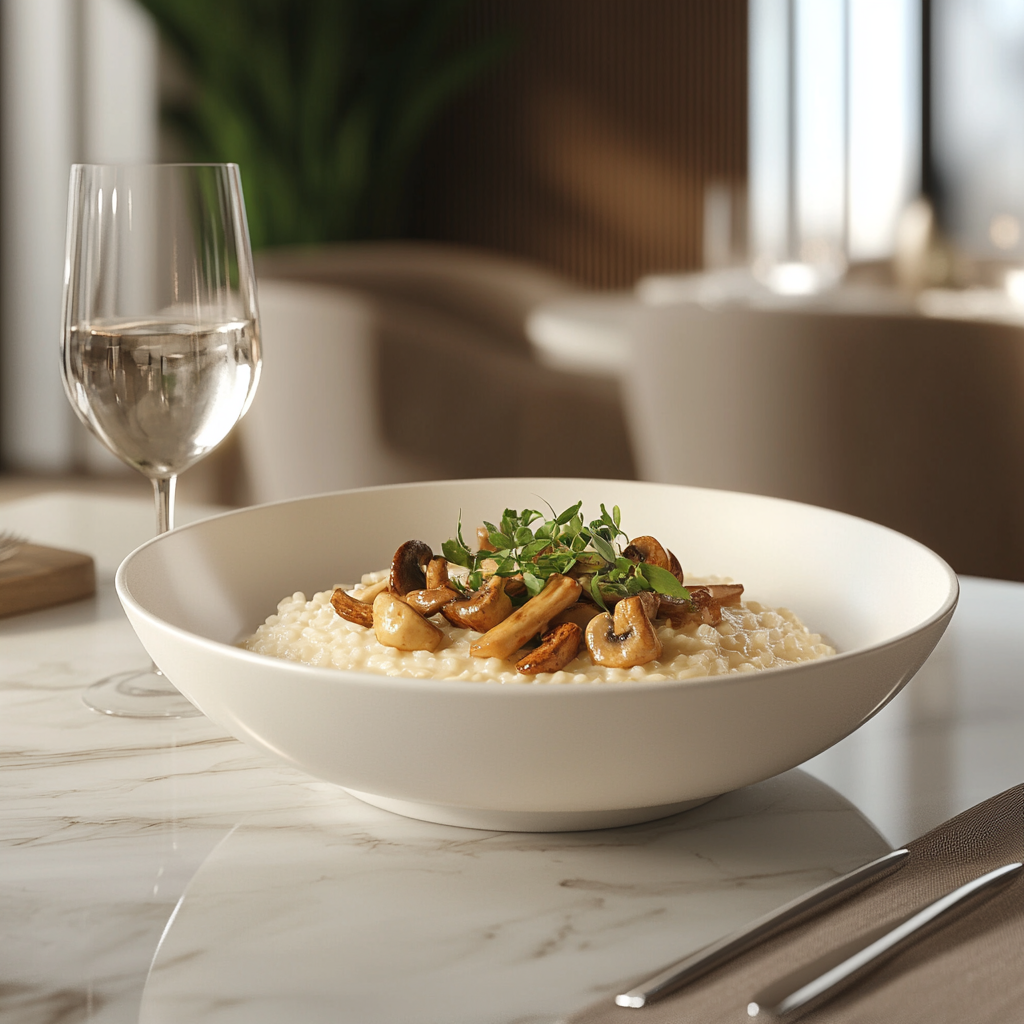1. A Taste of Italy in Your Kitchen
The aroma of risotto simmering gently on the stovetop can transport you instantly to an Italian trattoria. I remember the first time I tried authentic mushroom risotto. It was during a trip to northern Italy, where a friendly chef shared his passion for transforming simple ingredients into something extraordinary. The subtle earthy notes of mushrooms, the creamy texture of perfectly cooked rice, and the warmth of good company made it an unforgettable experience. Back home, I was determined to recreate that memory in my kitchen, and that’s how I began my journey of mastering authentic mushroom risotto the Italian way.
2. Introduction: The Charm of Authentic Mushroom Risotto
The Appeal of Authentic Risotto
Risotto is one of Italy’s most cherished comfort foods, a dish that embodies both simplicity and sophistication. Cooking authentic mushroom risotto is more than just following a recipe; it’s about understanding the essence of Italian cooking—the careful selection of fresh ingredients, the patience in stirring, and the love for flavors that evolve over time. Today, we will dive into the art of making this delectable dish, uncovering its secrets one step at a time.
3. What is Risotto Rice Called?
To cook an authentic risotto, you need the right rice. The most commonly used variety is Arborio rice. Arborio is a starchy, short-grain rice that absorbs liquid beautifully, creating that characteristic creamy consistency. There are other options, like Carnaroli and Vialone Nano, each with its own properties, but Arborio remains a popular choice for its ease of use and accessibility.
4. The Origins of Mushroom Risotto
Traditional Italian Cuisine
Mushroom risotto has deep roots in traditional Italian cuisine, particularly in the northern regions like Lombardy and Piedmont, where rice paddies are abundant. Italians cherish risotto as it showcases the humble ingredients that can be found locally—grains, mushrooms, and vegetables.
Regional Variations and Signature Touches
Each region in Italy may have its own twist on mushroom risotto. For example, Lombardy might feature porcini mushrooms, while in Piedmont, truffles could be added for a luxurious touch. The beauty of risotto lies in its adaptability.
5. Ingredients Needed for Authentic Mushroom Risotto
Arborio Rice and Its Unique Qualities
Arborio rice is prized for its high starch content, which is essential for creating a creamy risotto. Its short, plump grains absorb flavors well, ensuring that every bite is rich and flavorful.
The Importance of Fresh Mushrooms
Fresh mushrooms are key to an authentic mushroom risotto. Porcini, cremini, or even maitake mushrooms can be used to provide depth and umami flavor. Freshness ensures the mushrooms release their full earthy essence during cooking.
Stock Selection: Choosing the Right Broth
The broth is the heart of any risotto. A good-quality vegetable or mushroom broth works wonders in enhancing the overall taste. The stock should be warm when added to the risotto to maintain an even cooking temperature.
Adding Flavors with Aromatics
Garlic, shallots, and onions are aromatics that form the foundation of flavor in risotto. Their gentle sautéing releases natural sweetness, which melds seamlessly with the mushrooms and rice.
6. Preparing to Cook: Mise en Place
Why Preparation is Key
Mise en place, or putting everything in its place, is essential when cooking risotto. Having all ingredients prepped and ready before you begin ensures a smooth cooking process, especially since risotto requires constant attention.
Essential Tools You Need
A heavy-bottomed pan, a wooden spoon for stirring, and a ladle for adding broth are indispensable tools for making risotto. The heavy-bottomed pan helps distribute heat evenly, preventing the rice from scorching.
7. The Risotto to Broth Ratio: Getting It Just Right
Importance of Gradual Broth Addition
The risotto-to-broth ratio is critical. Typically, it’s around 1:4, meaning one cup of rice to four cups of broth. Adding the broth gradually, one ladle at a time, allows the rice to slowly absorb the liquid, resulting in a creamy texture.
Maintaining the Perfect Consistency
Risotto should be creamy but not soupy. Stirring while adding the broth slowly releases the starch from the rice, which is what creates that perfect creamy consistency. Patience is key here.
8. Cooking Authentic Mushroom Risotto Step-by-Step
Toasting the Rice: Developing Flavor
Start by toasting the rice in olive oil or vegan butter for a couple of minutes. This step helps develop a nutty flavor and prepares the rice to absorb the broth more effectively.
Adding Aromatics: Infusing Depth
After toasting the rice, add finely chopped onions, shallots, and garlic. Sauté until they become translucent, releasing their flavors into the base of the risotto.
Incorporating Mushrooms: Balancing Texture
Add sliced mushrooms to the pan and cook them until they’re soft and slightly browned. This step adds texture and umami to the dish, which is the signature of a good mushroom risotto.
Gradual Broth Addition: Achieving Creaminess
Add broth one ladle at a time, stirring constantly. Each ladleful should be absorbed before adding the next. This gradual process is crucial for releasing the starch from the rice, which creates the creamy consistency.
9. Tips for Making Mushroom Risotto Without Wine
Substituting Ingredients for Flavor
If you want to make risotto without wine, you can substitute with a splash of white wine vinegar or lemon juice for acidity. Alternatively, you can use extra broth, ensuring the flavors remain balanced.
Maintaining Authenticity Without Alcohol
While wine is traditional, it’s not mandatory for a delicious risotto. Focus on using quality broth and fresh ingredients to keep the dish authentic.
10. Variations: Exploring Different Types of Mushroom Risotto
Wild Mushroom Risotto
Wild mushrooms like chanterelles or morels can elevate the dish with complex flavors. Their unique textures and aromatic qualities add a special twist to classic risotto.
Maitake Mushroom Risotto
Maitake mushrooms, also known as “hen of the woods,” are perfect for risotto. They have a delicate, slightly peppery flavor that complements the creamy risotto base beautifully.
Vegetarian Mushroom Risotto Recipe
For a vegetarian version, use vegetable stock and add extra herbs like thyme and parsley for an aromatic boost. The dish remains hearty and rich without any meat-based ingredients.
11. Saffron Risotto: The Risotto alla Milanese
What is Risotto alla Milanese?
Risotto alla Milanese is a traditional risotto made with saffron, giving it a characteristic golden hue. It’s a Milanese specialty often served alongside ossobuco.
The Role of Saffron in Italian Cuisine
Saffron is one of the most expensive spices globally and is prized for its subtle, earthy flavor and vibrant color. It plays a crucial role in elevating risotto alla Milanese.
Recipe for Risotto alla Milanese
To make risotto alla Milanese, follow the same steps as mushroom risotto, but add a pinch of saffron threads to the broth. This imparts the distinctive yellow color and a luxurious flavor.
12. Cooking Tips for Consistent Results
Stirring Techniques
Stir gently but consistently to avoid breaking the rice grains, and ensure the starches are released evenly.
Timing and Heat Control
Cook risotto over medium heat, maintaining a steady simmer. Too much heat can cause the broth to evaporate too quickly, while too little can result in undercooked rice.
13. Health Considerations: Dairy-Free and Vegan Mushroom Risotto
Creating a Dairy-Free Risotto Mushroom Dish
Substitute butter with olive oil and use nutritional yeast instead of parmesan for a dairy-free version. These substitutions keep the dish creamy while accommodating dietary restrictions.
Vegan Mushroom Risotto: Substitutions and Tips
For a vegan version, use plant-based butter and omit any dairy cheese. Adding a touch of miso paste can introduce a savory depth, making up for the umami usually provided by cheese.
14. Serving Suggestions for Mushroom Risotto
Garnishing Ideas
Garnish your mushroom risotto with freshly chopped parsley, a drizzle of truffle oil, or toasted pine nuts for added texture and flavor.
What to Serve Alongside for a Full Italian Experience
Pair the risotto with a crisp green salad, crusty Italian bread, or roasted vegetables to round out the meal. A glass of Italian red wine makes a perfect complement.
15. Conclusion: Embrace the Art of Risotto Cooking
Celebrating the Simplicity and Sophistication of Risotto
Cooking risotto is about patience, attention, and respect for simple ingredients. It’s a dish that invites you to slow down and appreciate the cooking process.
Encouragement to Experiment with Your Own Twist
Once you’ve mastered the basic technique, feel free to experiment. Whether it’s adding different herbs, vegetables, or even playing with the broth flavors, risotto is versatile enough to accommodate your creativity, making it a delightful staple in your culinary repertoire.
Check out this Mushroom Risotto


